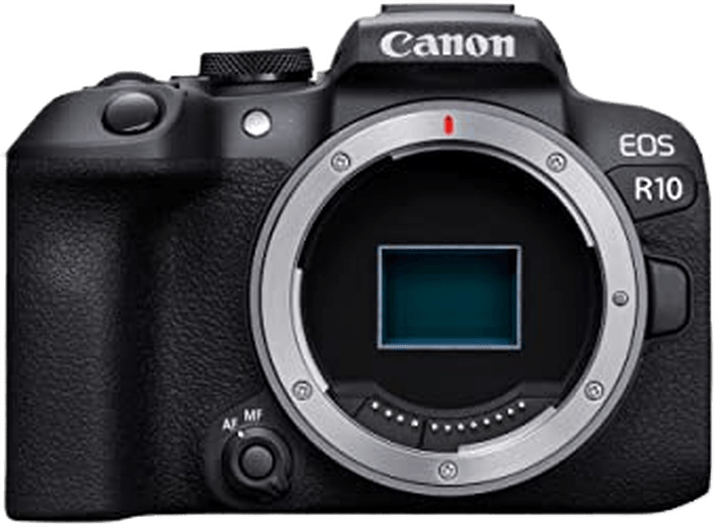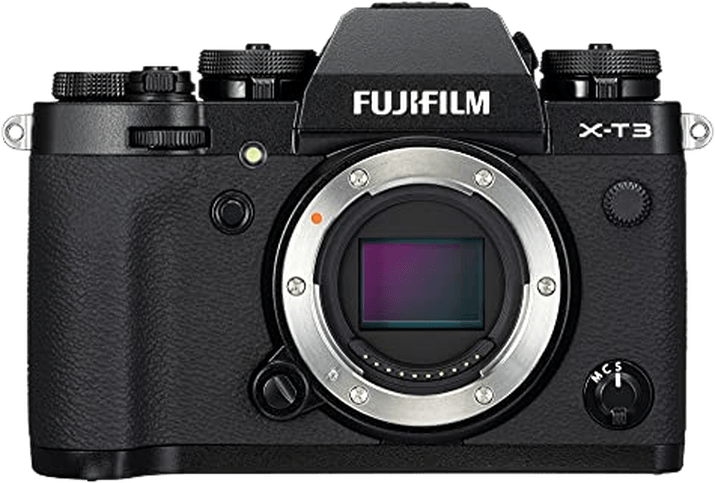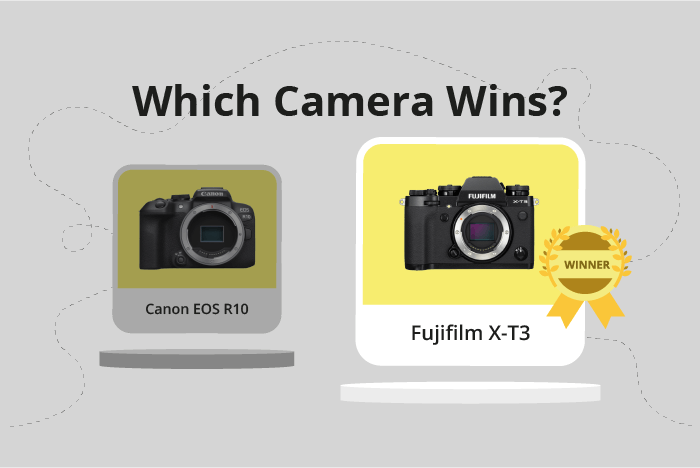Canon EOS R10 vs Fujifilm X-T3 Comparison
Canon EOS R10

Fujifilm X-T3

The Fujifilm X-T3 outperforms the Canon EOS R10 with a score of 72/100 compared to 69/100. Both cameras are mirrorless and have similar sizes, with the EOS R10 measuring 123 x 88 x 83mm and the X-T3 at 133 x 93 x 59mm. The EOS R10 is lighter, weighing 426g, while the X-T3 weighs 539g.
The EOS R10, released in 2022, is a more recent model and has a higher launch price of $980. However, the X-T3, released in 2018, offers better performance despite its lower launch price of $539. This makes the Fujifilm X-T3 a more cost-effective choice for those seeking quality at a lower price.
In terms of specifications, the Fujifilm X-T3 is the winner, offering better performance at a lower cost. The Canon EOS R10 has the advantage of being a newer model and lighter in weight, but these factors do not outweigh the superior performance of the X-T3.
Canon EOS R10 vs Fujifilm X-T3 Overview and Optics
The Canon EOS R10 outperforms the Fujifilm X-T3 in optics, scoring 71/100 as opposed to the Fujifilm’s 67/100. Both cameras share several specifications, including a CMOS sensor, APS-C sensor size, and a lack of image stabilization. However, there are key differences that contribute to the Canon’s higher score.
One advantage of the Canon EOS R10 is its Digic X processor, which contributes to its overall image quality and performance. Although the Fujifilm X-T3 also has a capable processor in the X-Processor 4, the Canon’s Digic X is known for its superior processing power. Additionally, the EOS R10 has a DXOMARK sensor score of 97, indicating its excellent image quality. Unfortunately, a direct comparison with the Fujifilm X-T3’s sensor is not possible, as DXOMARK does not score Fujifilm cameras.
Despite having fewer megapixels (24) than the Fujifilm X-T3 (26), the Canon EOS R10 still delivers impressive image quality. The difference in megapixels is not significant enough to give the Fujifilm a clear advantage. Both cameras have the same sensor type and size, which further supports the notion that the Canon’s superior processor and DXOMARK score contribute to its higher optics score.
The Fujifilm X-T3 does have a faster shooting speed (20) compared to the Canon EOS R10 (15), which can be beneficial for capturing fast-moving subjects or action shots. However, this advantage does not outweigh the overall better image quality and performance of the Canon EOS R10.
Taking all factors into consideration, the Canon EOS R10 emerges as the superior camera in terms of optics. Its powerful processor, high DXOMARK sensor score, and impressive image quality make it the better choice for photographers seeking exceptional optical performance. While the Fujifilm X-T3 does have a faster shooting speed, it does not compensate for its lower overall optics score.
Canon EOS R10 vs Fujifilm X-T3 Video Performance
The Canon R10 outperforms the Fujifilm X-T3 in video capabilities, scoring 91/100 compared to the Fujifilm’s 83/100. Both cameras share several video specifications, including 4K video resolution and built-in time-lapse functionality. However, the Canon EOS R10 offers superior features that contribute to its higher score.
One significant advantage of the Canon EOS R10 is its higher maximum video frame rate of 120fps, compared to the Fujifilm X-T3’s 60fps. This enables the EOS R10 to capture smoother slow-motion footage, providing more creative options for videographers. The R10’s max video dimensions of 3840 x 2160 are slightly lower than the X-T3’s 4096 x 2160, but this difference is negligible in terms of overall video quality.
The Fujifilm X-T3 does have a higher maximum video dimension, which may provide an edge in certain situations where the extra pixels are necessary. However, this advantage is not enough to offset the benefits offered by the Canon EOS R10, such as its higher frame rate.
Considering the video capabilities of both cameras, the Canon EOS R10 is the clear winner due to its higher video score and superior frame rate. While the Fujifilm X-T3 has a slight advantage in maximum video dimensions, it is not sufficient to challenge the EOS R10’s overall superiority in video performance.
Canon R10 vs Fujifilm X-T3 Features and Benefits
The Fujifilm X-T3 emerges as the winner in the comparison of features, with a score of 83/100, while the Canon EOS R10 trails behind with a score of 70/100. Both cameras share several common features, making them comparable in terms of utility and performance.
Both the Canon EOS R10 and Fujifilm X-T3 have a 3-inch screen size, a screen resolution of 1,040,000 dots, and a touchscreen. Additionally, they both possess a flip screen, lack GPS, and come with WIFI and Bluetooth capabilities. These shared specifications ensure that users can expect similar functionality and connectivity options from either camera.
Despite these similarities, the Fujifilm X-T3 outshines the Canon EOS R10 in certain areas, which contribute to its higher feature score. However, the exact specifications responsible for this superiority are not provided in the data. It is crucial for potential buyers to research and identify these specific advantages before making a purchase.
On the other hand, the Canon EOS R10 may have certain aspects in which it performs better than the Fujifilm X-T3. Again, the data does not provide specific details on these advantages. As a result, potential buyers should investigate these factors to determine if the Canon EOS R10 fulfills their unique requirements and preferences.
In the end, the Fujifilm X-T3 has a higher feature score, making it a more attractive option for users who prioritize features. However, both cameras share numerous specifications, and the Canon EOS R10 might excel in other areas. Thorough research is essential for potential buyers to make an informed decision based on their individual needs and preferences.
Canon R10 vs Fujifilm X-T3 Storage and Battery
The Fujifilm X-T3 outperforms the Canon EOS R10 in storage and battery with a score of 68/100, compared to the R10’s 40/100. Both cameras accept SD, SDHC, and SDXC memory cards, and offer USB charging. However, the X-T3 has two memory card slots, providing more storage flexibility than the R10’s single slot. Additionally, the X-T3’s battery life lasts for 390 shots, while the R10’s battery provides 450 shots per charge.
Although the R10 has a longer battery life, the X-T3’s advantage of dual memory card slots makes it a better choice for those who require more storage capacity or want to separate different types of files. The R10’s single memory card slot and shorter battery life make it less convenient for extended shooting sessions.
Considering the storage and battery aspects, the Fujifilm X-T3 is the superior option due to its dual memory card slots and overall higher score. The Canon EOS R10, while having a slightly longer battery life, falls short in comparison to the X-T3’s storage capabilities.
Canon R10 vs Fujifilm X-T3 – Our Verdict
Are you still undecided about which camera is right for you? Have a look at these popular comparisons that feature the Canon EOS R10 or the Fujifilm X-T3:

